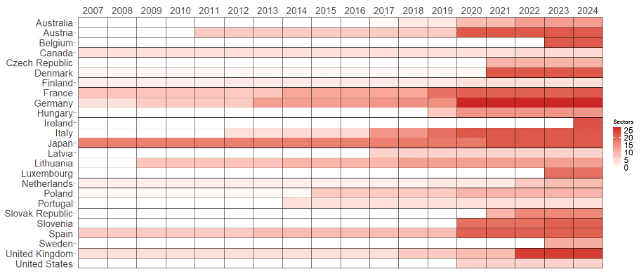Mapping FDI Screening Practices in Advanced Economies
By Lorenzo Bencivelli (Banca d'Italia), Violaine Faubert, Florian Le Gallo and Pauline Négrin (Banque de France)
Disclaimer: The views expressed are those of the authors and do not necessarily reflect those of the Banque de France or the Banca d’Italia.
In recent years, most advanced economies have adopted or tightened their existing foreign investment screening mechanisms (ISMs), which empower national authorities to restrict foreign takeovers in strategic sectors. In 2019, the EU adopted a regional cooperation framework on FDI screening. We document the outcome of screening decisions in several advanced economies. Although a large number of transactions is subject to review, the number of blocked transactions is limited, suggesting that ISMs strike a balance between openness to FDI and protection of national interests.
The rise of foreign investment screening in advanced economies
Over the past decade, most advanced economies have adopted or tightened their existing investment screening mechanisms (ISMs), which empower national authorities to review, condition or prohibit, acquisitions that potentially threaten national security.
In assessing the potential risks posed by a transaction, most countries focus on two factors: i) the effects on strategic sectors (e.g. critical infrastructure, critical technologies, supply of critical inputs, access to sensitive information, freedom and pluralism of the media…) and ii) whether the foreign investor is controlled by the government of a third country.
An increasing number of advanced economies, which have traditionally been open to foreign investments, adopted or overhauled their existing ISMs from the early 2010s onward (Figure 1), either with sector-specific, cross-sectoral or mixed mechanisms. Countries that screen transactions in specific sectors have expanded the number of sectors subject to review over time, from 4 on average in 2007 to 15 in 2023. Figure 2 shows the ever-increasing number of sectors covered by sector-specific ISMs. Alongside these national developments, the EU adopted in 2019 a common FDI screening framework aimed at enhancing cooperation among Member States.
Figure 1: The rise of investment screening mechanisms in advanced economies

Note: Most countries that did not initially have an ISM (white tiles) have adopted such mechanisms over the past decade (green). A number of countries have shifted from sectoral mechanisms (where the government has the authority to review a list of sectors, shown in light green) to a cross-sectoral (green) or mixed mechanism (dark green), where the government can review investments in any sector and subject a specific list of sectors to stricter review requirements.
Source: PRISM database; © Bauerle Danzman and Meunier (2023).
Figure 2: Expanding number of sectors screened over time

Note: The number of sectors covered in a sector-specific mechanism ranges from 0 (white) to 28 (dark red). Zero values may reflect two different situations. On the one hand, Italy adopted a sectoral ISM in 2012 and hence, had no screening in place from 2007 to 2011. On the other hand, Australia (in 2017) and the USA (in 2020) moved from a cross-sectoral mechanism (where the government can review investments in any sector) to a mixed mechanism (where the government can i) review investments in any sector and ii) subject a list of sectors to stricter review requirements).
Source: PRISM database; © Bauerle Danzman and Meunier (2023).
Literature focuses on ISMs as a response to the rise of Chinese outward investment (Chan and Meunier, 2022), national security threats in Central and Eastern European countries from Russia (Bauerle Danzman and Meunier, 2022) and technology transfer associated with foreign acquisitions. For instance, Eichenauer and al. (2021) show that EU countries with higher technological levels were more supportive of FDI screening due to concerns over unreciprocated technological transfer. More recently, the Covid-19 pandemic strengthened governments’ commitment to prevent the sale of strategic domestic assets to foreign investors (Evenett, 2021).
Impact of FDI screening on transactions
Assessing the impact of FDI screening on transactions is challenging for a number of reasons. First, little public information is available on the outcome of screening decisions for confidentiality reasons. Second, only a few jurisdictions publish data on the overall annual number of FDI transactions, which contributes to challenges in assessing the proportion of transactions subject to review as a share of all inward transactions. Third, differences in the scope of national screening laws contribute to challenges in comparing screening practices. While most countries focus on national security considerations when screening investment, a few countries, like Australia and Canada, also rely on a “national interest” test. This broad concept allows host country authorities to consider a wide range of public interests that the planned investment touches upon, such as its effects on employment, tax revenues, etc. Other challenges relate to differences in the sectoral scope of national screening laws and to investor-related parameters: while in some countries, screening applies equally to potential foreign and domestic investors, a number of jurisdictions exempt specific nationalities from the application of all or parts of the screening rules.
Using national governments’ statistics on foreign investment applications, we document the outcome of screening decisions in major advanced economies (Bencivelli et al., 2023). We focus on screening decisions both at the national level and at the EU aggregate level to document the impact of the EU cooperation mechanism.
We find that a large number of transactions is subject to review. In the USA and in the EU as a whole, screened transactions represented about 20 % of the total number of FDI transactions in 2022 (Figure 3). This share is close to 50 % when greenfield investments are excluded. Indeed, greenfield investment corresponds to the creation of new businesses, whereas brownfield investment aims at acquiring control of an existing local firm. While both greenfield and brownfield investment constitute direct investment, greenfield investments do not fall within the scope of most national screening laws.
Among EU Member States, the proportion of investment proposals subject to review as a share of all inward investment transactions reached 12 % in Finland in 2022 and 20 % in France in 2021 (OECD, 2024). In both countries, this proportion has grown over the past few years (OECD, 2024).
Figure 3: number of screened inward investment proposals as a share of all inward investment transactions in the EU and the United States

Note: in 2022, transactions screened in the United States and the EU accounted for almost 20 % of all inward investment transactions, and more than 45 % when considering only brownfield investments.
Source: European Commission third annual report (2023) for the number of screened transactions and Staff Working Document (2023) for the number of transactions, Committee on Foreign Investment in the United States (CFIUS) (2023) for the number of screened transactions and Bureau of Economic Analysis (BEA) for the number of transactions; authors’ calculations.
We also show (Bencivelli et al., 2023) that although a large number of transactions is subject to review, the share of blocked transactions is extremely limited: only 1 % of all transactions for the EU and no transaction in the United States in 2022 (Figure 4). However, a significant number of transactions were withdrawn during the review process in the USA (26 % in 2022). Such transactions are either definitively abandoned or else withdrawn and re-filed. A handful of countries, such as Canada, block a higher share of transactions.
By contrast, transactions authorized with conditions are relatively frequent. In most countries, about 10 % of all transactions are accepted with conditions. This proportion reached 22 % in France in 2022 (Figure 4).
Figure 4: outcome of national security reviews

Figure 5: Screened transactions by business sector in the USA and the EU in 2021 and 2022

Notes: EU figures refer to notified transactions under the EU cooperation mechanism (extra-EU flows). For the
USA, the scope of screened transactions includes declarations and notices. In the EU, manufacturing represented 16 % of all foreign transactions in 2022 and 27% of screened transactions in 2022.
Sources: European Commission (2023 and 2023), BEA, CFIUS annual report (2023); authors’ calculations.
Overall, the main targeted countries broadly correspond to the main trading partners. Investments from the USA represented 32 % of all transactions screened in the EU in 2022 (Figure 6), which is broadly in line with the share of US inward FDI into the EU. However, China is slightly over-represented in the number of screened transactions both in the USA and the EU over the past few years, reflecting the focus of most ISMs on investors controlled by foreign governments. In most countries, anecdotal evidence and official statistics (when available) suggest that investments involving Chinese investors comprised the bulk of blocked transactions.
Figure 6: screened transactions by origin of the investor in the USA and the EU in 2021 and 2022

Notes: EU figures refer to notified transactions under the EU cooperation mechanism (extra-EU flows). For the
USA, the scope of screened transactions includes declarations and notices. China represented 3% of all foreign transactions (acquisitions of equity stakes and greenfield investments) in the EU in 2022 and 5% of the total number of screened transactions. “Other” countries include Japan, the Cayman Islands and Singapore, amongst others.
Sources: European Commission (2023 and 2023), BEA, CFIUS annual report (2023); authors’ calculations.
Conclusions
Determining whether the recent tightening of ISMs has affected foreign investment flows is challenging. First, mapping the outcome of national screening decisions is difficult owing to data availability issues. Second, foreign investment screening is one of many factors that could influence FDI inflows. Literature suggests that the key determinants of FDI flows are sound macroeconomic conditions (investment returns, access to markets...), together with institutional factors (good governance, low sovereign risk and a stable legal system). In this respect, transparent foreign investment screening regulations and increased transparency on the outcome of screening decisions may improve the perceived transparency of national regulations.

